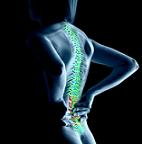Patients whose chronic pain is due to one of the following sources is a MUA candidate: (partial list)
-
Frozen Shoulder
-
Fixed articulations from adhesion syndrome
-
Herniated disc w/out fragment
-
Bulging disc
-
Protruded disc
-
Failed back surgery
-
Fibromyalgia patients
-
Chronic sprain/strain
-
Unresponsive muscle contracture
-
Chronic neuromusculoskeletal conditions
Manipulation under anesthesia uses a combination of manipulations, passive stretches and specific articular and postural kinesthetic maneuvers in order to break up fibrous adhesions and scar tissue around the spine and surrounding tissue.
Which patients should be considered for MUA?
Certain neck, mid back, low back or other spinal conditions respond poorly to conventional care. One proposed theory for this  is that, as a result of past or present injury, adhesions and scar tissue have built up around spinal joints and within the surrounding muscles causing chronic pain. Patients often undergo various treatments, such as physical therapy, chiropractic care, epidural injections, back surgery, or other treatments that do not address fibrous adhesions. Some patients feel temporarily better with these treatments, but their pain often returns. In general, patients selected for manipulation under anesthesia are those who have received conservative care for six to eight weeks. If limited or no improvements in symptoms or objective findings have occurred, then Manipulation Under Anesthesia may be an appropriate alternative.
is that, as a result of past or present injury, adhesions and scar tissue have built up around spinal joints and within the surrounding muscles causing chronic pain. Patients often undergo various treatments, such as physical therapy, chiropractic care, epidural injections, back surgery, or other treatments that do not address fibrous adhesions. Some patients feel temporarily better with these treatments, but their pain often returns. In general, patients selected for manipulation under anesthesia are those who have received conservative care for six to eight weeks. If limited or no improvements in symptoms or objective findings have occurred, then Manipulation Under Anesthesia may be an appropriate alternative.
Prior to treatment, protocols of diagnostic testing should document the nature of the diagnosis, support the need for treatment and eliminate questions of psychosocial factors that can influence pain responses. In addition to X-ray, MRI scan or CT scan, a musculoskeletal sonogram or nerve conduction velocity test may be ordered.
Manipulation Under Anesthesia is designed to stretch or tear the particular adhesions that form around the articular facets of the spine which are usually caused by time, trauma to the spine or by herniated or bulging discs. These particular adhesions are what tend to lock the spine in a state of fixation, preventing normal movement and causing pain. The paraspinal muscles cause a splinting or guarding at the adhesion site which make the traditional chiropractic manipulation less effective.
By placing the patient in a twilight anesthesia, a complete relaxation of the paraspinal muscles is achieved allowing the doctor to directly influence particular adhesions by diminishing the postural musculature. Since the adhesions are aneurovascular, there is no bleeding or pain following the manipulation. The benefits of this procedure are numerous, including a return to normal spinal movement, the normal structural integrity of the spine is reestablished, an elimination of symptomatic pain, and an increased range of motion.